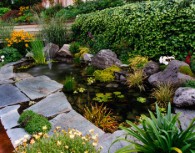 One way of making your garden more interesting is by incorporating a water feature – and creating one doesn't have to be a laborious process.
One way of making your garden more interesting is by incorporating a water feature – and creating one doesn't have to be a laborious process.
They can also be excellent ways of attracting wildlife to your garden, providing a haven for many species. According to the Royal Horticultural Society, nearly 70 per cent of ponds have disappeared from the countryside over the past century, so putting one in your garden can help to restore this habitat.
If you're keen on creating a pond, now's the time to start planning, because autumn and winter are the best times to do so.
There are plenty of other water features to consider if your garden isn't suitable for digging a pond. Stone troughs or baths are ideal for patios, while watertight wooden barrels can also be used.
When planning, you should think about the kind of plants you want to grow, as they will require different depths of water. Siting is also important – make sure you avoid areas that are too shady, particularly with nearby deciduous trees, although some shade can help to reduce algae problems.
You can use string to mark out the perimeter of the pond before you start excavating. Dig out the first shelf and mark it out before you start work on the centre of the feature, adding additional shelves as required. One of the sides should be gently sloping to ensure animals that fall in have an escape route.
The depth of the pond is your choice, but in general 20-60cm (8in-2ft) varied across the pond will suit most pond flora and fauna.
After you've finished digging, remove any sharp stones and line the area with builders' sand. Pond overlay or a piece of old carpet can then be used to provide support for the butyl liner, which is the best material to use for creating a water feature.
Spread the liner evenly over the surface and secure the edges using bricks before filling it with water. Trim the sides and cover with paving slabs, or lay turf up to the water's edge for a more natural effect.
Many ponds can be left so that they are colonised naturally by plants and animals. However, if you wish to choose your own flora, native plants make the best choice.
Dense vegetation on one side of the pond can provide cover and breeding sites for wildlife. Aim to achieve a surface plant covering of between 65 and 75 per cent, and add submerged oxygenators.
Once you've finished your pond, you can wait for the wildlife to arrive – newts, frogs, dragonflies and mayflies could all take up residence in your garden.
Regular maintenance work is essential to ensure your water feature remains in good condition. Top it up during dry summer weather, and control weed and algae to make sure you maintain the optimum level of vegetation coverage
Silting up can be beneficial for wildlife, but if you need to remove some, it's best to do so in the autumn.




